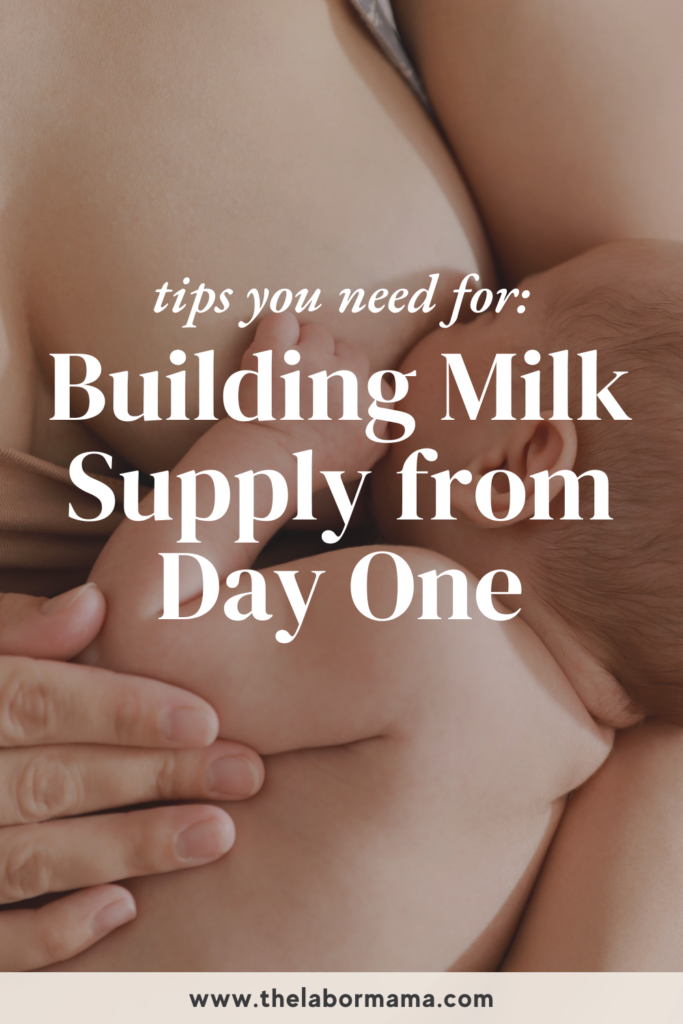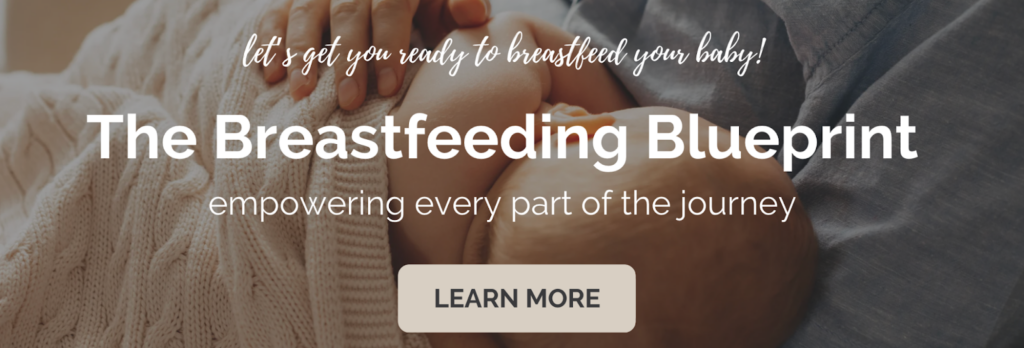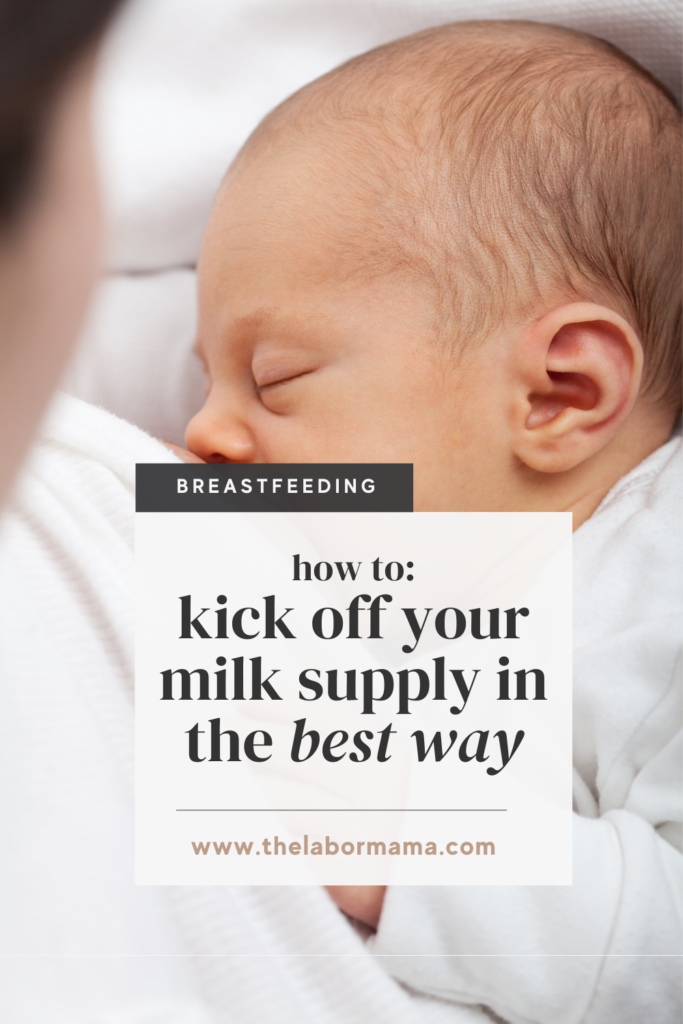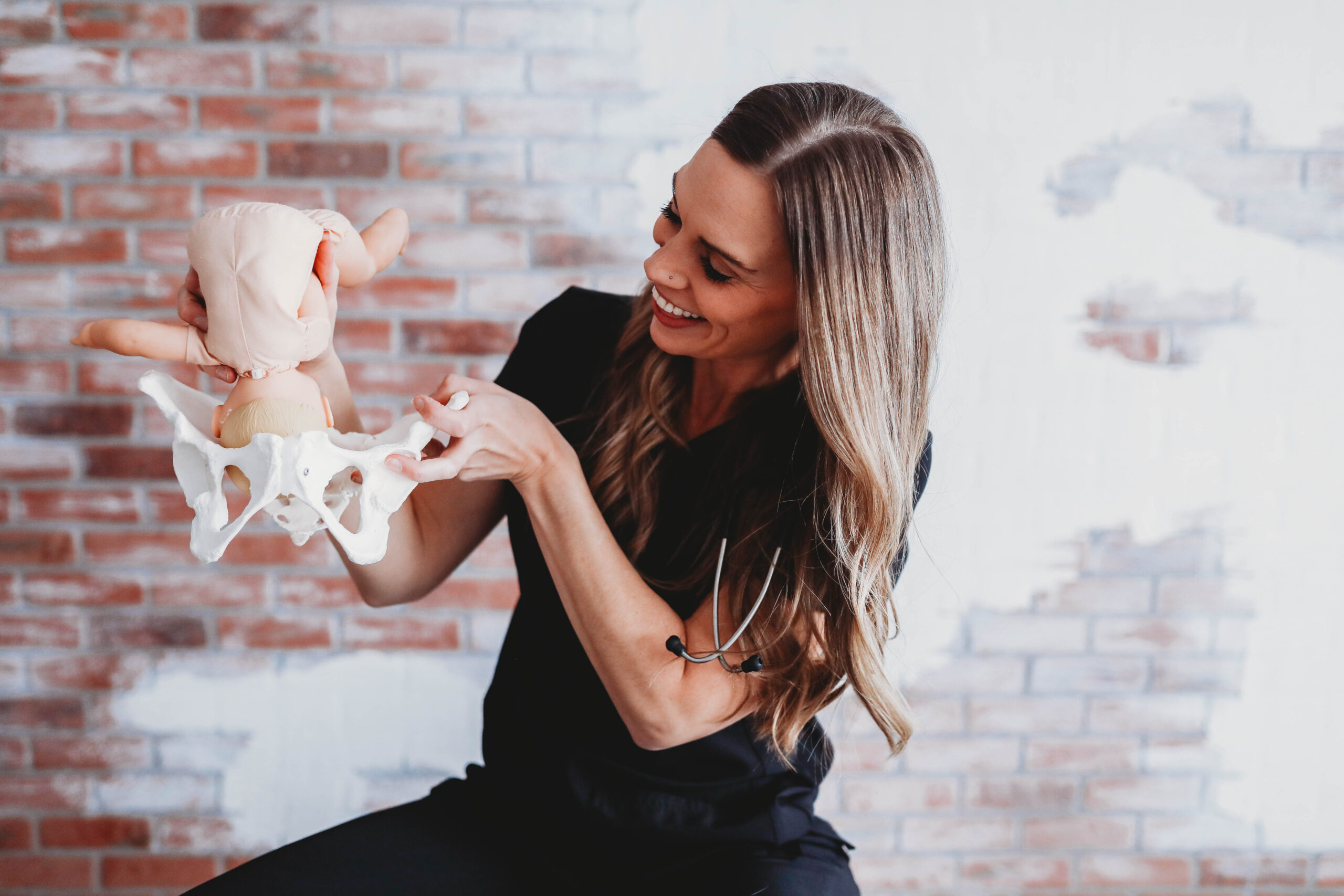Pregnant and thinking ahead to your breastfeeding story? I know I always am! Regardless of what has or hasn’t happened with my prior baby(ies), I’ve always been so aware that every mama/baby couplet is so different! And I’ve seen this in my repeat patients time and again too. I absolutely think the wisdom of prior experiences helps guide us in our next stories, but it’s also a really good idea to approach your breastfeeding relationship, and the idea of a healthy milk supply as a bit of a brand new expience each time too.
So, whether your a first time mama wondering about all of this or it’s your fifth, let’s get into the things you should definitely consider as work toward a strong milk supply and a healthy breastfeeding relationship.

Who is The Labor Mama and Why Am I Here?
Hey friend! I’m Lo – also known around here and social media as The Labor Mama. I’ve spent my nursing career in labor, delivery, and postpartum, have birthed 4 of my own babies, have labored thousands of mamas at the bedside, have taught hundreds of students online, and have even delivered a few speedy little babies with my bare hands (oops).
Here at TLM, I offer online classes to empower you the way everyone should be. The education + support I offer gives you experience, evidence, and empathy; you’re getting all of my years of “clinical” RN knowledge, beautifully combined with my real experiences as a mama and a nurse. These are not your average hospital classes (those won’t do it, I promise), and honestly, birth, postpartum, and breastfeeding don’t follow a textbook or protocol anyway. You need to know so much more than that!
If you want to connect with me further, head to Instagram. There are hundreds of thousands of us over there learning together daily.
A note: This post may include affiliate links. This means if you make a purchase after clicking a link, I will earn a small commission (thank you)! Rest assured, this comes at no additional cost to you. You can read TLM’s full disclosure here.
How to support breastfeeding before the birth
What I really want to do here is talk about breastfeeding, day 1, and all that you can do to get off to a great start. But I absolutely cannot deny that there are some great things to do before baby is born that are super valuable too! So if that’s where you’re at right now, check these out and see if you can make any of this happen!
Alright, here are some ways to prep for breastfeeding before baby gets here:
01. Find and/or choose a lactation counselor. Many hospitals offer lactation support while you are an inpatient, and some hospitals also offer going support after you discharge. Spend some time figuring out who your go-to resource will be! Check out what your insurance will cover. Even if you never need this person, it is much better knowing exactly who you are going to call when or if something comes up.
Not sure where to start? Check out the International Lactation Consultant Directory and take a peek at my breastfeeding course, The Breastfeeding Blueprint!
02. Ask your OB provider about any known health history you have that could make breastfeeding tougher. Things like PCOS or diabetes may be a possible indicator for low supply, and if you struggled with a prior baby, it can be great to discuss the whys with your provider or the LC you’ve found.
03. Establish a support system. Research actually shows us that one of the things that is most encouraging to us breastfeeding is seeing it! Do you have other breastfeeding friends who can help, support and encourage you? Have you shared your goals with your partner and your family? Is there a local moms or community group you can be a part of? The fastest dropoff in breastfeeding happens in the 10 days following discharge from the hospital. So get your people in your corner! Their support (and insight) will likely be something you really need.
04. Learn the skill of hand expression: We’re about to cover it! Keep reading – it’s SO valuable!!!
Breastfeeding and milk supply on the first day
Let’s get into that first actual day with baby, and specifically the first few hours! These hours are incredibly important for establishing your milk supply, so you really want to take full advantage of this time together.
Skin to Skin + The Golden Hour
Have you heard of skin to skin and the golden hour? Skin to skin is the practice of placing baby directly on your bare chest (or someone else’s too) and then just spending time with them there! In the “ideal” birth scenario, you deliver your baby and they go directly to your chest for skin to skin.
When this happens, it kicks off what is commonly referred to as ‘The Golden Hour’ – at least 60 minutes of time that baby spends on your chest, uninterrupted. This can happen after both vaginal birth and cesarean births, so it’s super important to understand what it is, plan for it, and advocate for it! Most care providers and hospitals are totally on board with this practice, but it is also possible that you may have to verbalize that you’d like more time or that you’d like to delay something (like a shot or an assessment) until you’ve gotten the time you want.
Honestly, unless something medically demands that baby leave your chest, you really should be able to have this time – and it’s benefits are great…so let’s get into them.
Benefits of the Golden Hour
Like I said, the Golden Hour has some incredible benefits, and many of them specifically pertain to breastfeeding. It’s kind of wild to me all that this time together can potentially do. Here are some of those benefits:
- Reduction of stress: When a baby is placed skin-to-skin, it can actually slow your production of adrenaline. This is great, because adrenaline can interfere with oxytocin and prolactin (which are both primary breastfeeding hormones). Babies show decreased stress hormones too.
- Skin to skin regulates baby’s body systems: Skin-to-skin helps babies regulate their body temperature (helps them keep temps up) and it can lower their risk of low blood sugar levels.
- Enhances baby’s immune function: Exposure to you, both in the birth canal and during skin-to-skin, helps baby “learn” about good and bad bacteria. Basically, skin to skin kicks the immune system on and it starts learning right away.
- Promotion of bonding: You have MORE oxytocin receptors on your brain after pregnancy and skin-to-skin causes oxytocin to be produced! Basically, your brain is super receptive to this love hormone – let the bonding (and breastfeeding) begin.
- Initiation of Breastfeeding: Skin-to-skin is linked to more successful rates of breastfeeding initiation and duration.
Ok, I’ve got to do it: It’s really important that I pause here and address those who may not get to do The Golden Hour. Perhaps your baby is in the NICU, you’re groggy from magnesium, or you experience a postpartum hemorrhage. There are reasons skin-to-skin doesn’t happen (and I’ve seen that many times!) – and I do NOT want you to feel any guilt about this. Not getting to do skin-to-skin immediately does not mean that breastfeeding will fail or your baby is compromised or the two of you won’t bond – not at all! Skin to skin maintains amazing benefits for months and months, so get that little to you (or someone else’s chest) as soon when you can – and enjoy that precious time ♥️.
Establishing a Healthy Milk Supply Early
Ok, let’s jump from that golden hour for a minute and speak to that healthy milk supply too. Research is abundantly clear that one of the best ways to kick off milk supply and support it over the long term is to have milk expression within the first hour after birth and then frequently (every 2-3 hours) after that. Research also shows that early expression can bring milk in sooner! Early milk removal can occur via baby or mother, but ultimately, the goal here is to have milk moving out within 60 minutes of birth!
“Expressing first milk (colostrum) in hour one vs. hours 2-6 post-delivery decreased the time before production accelerates and increases supply by 130% at 6 weeks.” Source
Will baby latch in the first hour?
Ok, so you’ve got it. The goal is – milk out within the first hour, right? And I’m making a guess that right now your ideal is that baby latches on in these first 60 minutes and kicks off that first important session of expression, as opposed to you having to do something else. But will baby latch? Can they? Is there something you can be doing in this first hour?
Widstrom’s 9 Stages
Have you ever heard of Widstrom’s 9 Stages? Or maybe the phrase “breast crawl?” Widstrom’s 9 Stages happen in the first 60 minutes or so after birth – during that Golden Hour time we just talked about. They refer to different “actions” the baby is taking during skin to skin, as they transition to life outside and make their way to your breast to eat.
Here’s the full list:
- The Birth Cry
- Relaxation
- Awakening
- Activity
- Rest
- Crawling
- Familiarization
- Suckling
- Sleep
As you can see, in an ideal scenario those 9 stages ultimately end in baby self-attaching (step 7-8) to the breast. The first feeding occurs within those 60 minutes and all we do is sit back and watch! Easy enough, right?! ?
However, sometimes things like labor medications, interventions in birth or postpartum, the age of baby, or mode of birth can make baby a bit sleepy or a bit slower to transition and that can impact how quickly a baby moves through these stages. Or sometimes, you’re trying to stay hands off, let baby do their thing, they’re trying to latch, but it just seems as if they haven’t quite figured it out yet. What can you do in this scenario – knowing that a feed in this first hour is so important in establishing supply?
If you haven’t yet, many choose to make this first latching process a little more collaborative, and try to help baby to the breast and get them latched. But, what about if you are working together, things still aren’t quite clicking, and baby still isn’t latching well in this first hour? Then you definitely want to consider making use of your hands and doing some manual hand expression.
Hand Expression After Birth
Up in the breastfeeding prep section, I mentioned learning the skill of hand expression. When you do this before birth, it is called antenatal hand expression. Typically, this colostrum collection is a process that most of us can start doing around 37 weeks or so of pregnancy. Please check with your provider if you want to start practicing and collecting! In some rare occasions, it is not safe to do so.
This prenatal hand expression has multiple benefits, including:
01. Any colostrum you collected in those final weeks can be saved and fed to your baby after birth!
02. Getting comfortable with this process prenatally means you will feel more than comfortable doing it now, after the birth!
Why is hand expression so valuable?
When we were first discussing a strong start to a healthy milk supply, I mentioned a few ways early expression can really impact your supply and the research that supports that. I wanted to summarize some of that here for you, so you really understand the power and value of using your hands in these first hours and days, particularly if baby and you are not quite figuring it out (yet).
Benefits of early and frequent colostrum expression (Source, Source, Source):
first hour collection:
- Can decrease the time it takes for milk to come in
- Has been linked to 130% more milk at 6 weeks postpartum
collection through first days:
- Mothers find it more comfortable to do
- Volumes collected are more than what is collected via electric pump
- Greater fat content in colostrum
- Infants who receive colostrum after feeds lose less weight/begin gaining sooner
- Higher breastfeeding rates at 2 months
When it comes to hand expression post birth, the practice is basically the same as it is prenatally. Check out this video (click term baby)… it’s helpful! Of course, prenatally, you would be collecting and then freezing any colostrum you collect for later use. After birth, you can simply collect what you get via spoon, syringe, or a medicine cup that the hospital should easily be able to provide and then give that to baby! Your RN should know about this practice and be able to support you and offer help at this time too!
Hand expression after the first hour
One thing I want to point out – and this was mentioned on that benefits list – is that hand expression is not just for that first hour after birth or for when baby isn’t yet latching. It is also a great practice to do throughout the first couple of days as your milk is moving towards transitional milk. This could look like nursing baby at the breast every couple of hours, spending some time doing hand expression when they’re done, and then spoon feeding or syringe feeding whatever you’ve collected to baby as their “dessert.” This practice, of giving those bits of extra supplementation of your own milk, has been linked to less newborn weight loss!
Is there enough colostrum?
When you do this hand expression, it’s also valuable to remember that you aren’t taking anything from baby or emptying your breasts in a way that then means there won’t be anything there when baby latches again. The body is continually making milk, the latching and the expression are stimulating the nipples and increasing your milk making hormones progesterone and oxytocin, and all of that is actually encouraging your body to move into and through Stages 2 and 3 of lactation and towards that plentiful, mature milk.
the takeaway on a healthy milk supply
Alright, I feel like I just threw a lot of information at you, so let’s summarize what’s here. The first hours (and the first days) of baby’s life can be super important establishing a healthy milk supply and supporting your longer term breastfeeding relationship. Milk expression (whether that occurs via baby latching or hand expression) in the first 60 minutes is one of the best things you can do to support your milk coming in and your supply moving forward. If your baby is not able to latch, whether via self attachment or with your help in the process in that first hour, then consider hand expression! You can also continue to hand express every few hours for the first couple days. All of this stimulation is incredibly valuable to your milk supply and whatever colostrum you collect can be fed to your new baby as well.
If information like this feels SO valuable, I want you to know that I can help further! Breastfeeding is amazing – and hard – and it is so easy to get lost down the 2am Google hole while that tiny baby is in your arms. I want to help. I can help! Because I have been that googling (crying), worried mama. I have been you.
You can hear some rough breastfeeding stories and feel scared OR you can hear those stories and get informed. You can take the knowledge from someone like me – a CLC, former postpartum RN, and mama who has now breastfed 4 babies well past a year – and turn around and apply that directly to your story. You can save yourself time, money, tears – because I’ve already done all of that. Knowing how this all works, knowing how to correct any bumps in the road, knowing that there are answers to the questions that will almost certainly come up – that’s the game changer.
Having support, knowledge and education like that can change everything.
Join me in The Breastfeeding Blueprint. I will save you time, tears, challenges – and give you back joy and pride in this season with your baby! Steal my experiences and change your own.

Does this help? Do you see the value in this early expression? Have you utilized hand expression, either prenatally, after birth, or both? I’d love to hear about your experience! xx- Lo

More resources (and freebies!) for you to take a peek at are below, and don’t forget about my online course options here:
Loved this blog post? Here’s some others you’ll probably like:
- Understanding & Dealing With Postpartum Engorgement
- The Best Lactation Cookies & Energy Bites For Milk Supply
- How To Build A Breastmilk Freezer Stash
More resources (and freebies!) for you to take a peek at:



